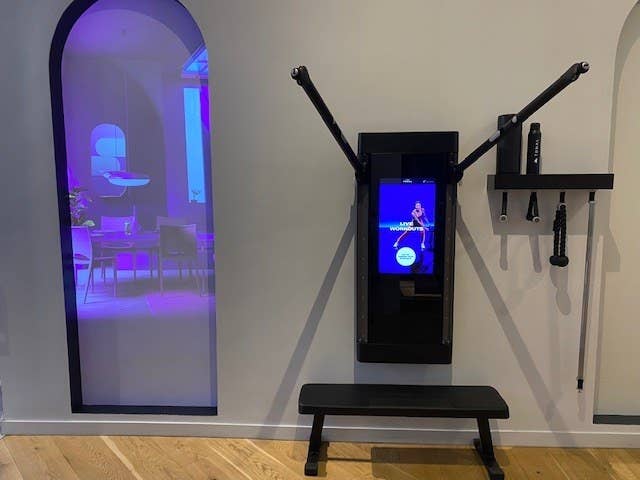
We hope you love the products we recommend! All of them were independently selected by our editors. Just so you know, BuzzFeed may collect a share of sales or other compensation from the links on this page if you decide to shop from them. Oh, and FYI — prices are accurate and items in stock as of time of publication.
Along with many other changes, the pandemic ushered in a new emphasis on at-home exercise equipment — some of it pretty pricey. Yes, Peloton was founded in 2012 and the Mirror launched in 2018, but you never heard much about them until spring 2020, when lockdowns and gym closures meant that most people exercised at home or not at all.
More recently, a strength training–focused machine called Tonal has been getting attention, due in part to the company’s notable lineup of celebrity spokespeople, including Serena Williams, LeBron James, Steph Curry, and Maria Sharapova.
Tonal is basically a digital screen that attaches to your wall (a professional installation is necessary) that has an attached pulley system for strength training. You can use the screen to access workout videos, connect with other users, and track your progress.
Another reason (aside from COVID) that Tonal may be charging into the spotlight is that muscle-building workouts are sweeping through the fitness space at the moment.
“Whether it's body composition, athletic performance, or even endurance athletes, I always just tell people strength is kind of like the foundation or base for pretty much everything,” said Tony Gentilcore, cofounder of Cressey Sports Performance, which is a high-performance athletic training facility in Boston. For endurance athletes, like his clients who are interested in running the Boston Marathon, Gentilcore advises strength training to help them put more force into the ground and propel forward.
Strength training can be intimidating for a beginner, especially at the gym or without a personal trainer offering guidance. While the Tonal sounds like a good idea — who wouldn’t want to try the machine that Serena Williams supposedly uses to train? — is it really worth $3,000 or more to do so? I decided to review one to find out.
Testing out Tonal
Tonal addresses those deterrents in what I genuinely believe to be one of the most compact home workout formats I’ve seen, which could be really useful for people who have small spaces or live in smaller homes.
I visited their Fifth Avenue showroom in NYC for a demo, which anyone can do at no cost if there’s a nearby location. (Tonal is now available at 40 Nordstrom retail stores in 24 states nationwide.) You can also check it out via a live video demo if there are no physical locations near you (or you’d just prefer to do it at home). I’d recommend the in-person experience if possible since adjusting the arms and attaching the smart accessories for the strength assessment can be tricky to figure out on your own.
Aside from the price point, my biggest concern about Tonal is the potential difficulty of navigating the equipment and interface. It is not impossible. But as with any technology, there will likely be a learning curve.
How much does Tonal cost?
The standard machine consists of a mounted mirrorlike touchscreen display with an adjustable arm on either side (for $2,995). The arms remain flush with the screen when they’re not in use, so it really does just look like a fancy mirror you might see on any wall in your home.
That being said, the screen alone is relatively pointless unless you purchase the smart accessories bundle, which is an extra $495. The bundle includes two smart handles, a smart bar, and a rope, all of which can attach to one or both of the arms and allow the machine to adjust the weight based on your own personal strength. It also includes a bench, foam roller, and workout mat. Without these accessories, I don’t see how you could get a tailored experience; it would just be a screen that projects workout videos.
The bench is fairly slim and can sit under the machine without taking up too much additional space, while the rest of the accessories can hang from a sleek black mount that protrudes about the same distance from the wall as the screen. On top of that, delivery with professional installation (which is required for the warranty) is $250, and the Tonal membership that gives you unlimited access to the full library of workouts is another $49 per month and it's mandatory for the first 12 months.
While the device is relatively compact, you still need 7 feet of vertical and horizontal space to install it and a 7-foot-10-inch ceiling height. Also necessary is a grounded three-prong outlet and walls that can support the nearly 150-pound device. (Tonal is able to generate up to 200 pounds of resistance by using an electric motor.)
There’s no doubt that the equipment and membership add up to a lot of money.
Here’s why you might want a Tonal
The thing is, my brother just turned his suburban basement into a home gym, which takes up about 10 times the space with 20 times the pieces of equipment. (He bought a bench press with various weights, Bowflex adjustable dumbbells, a stationary bike, and a mini treadmill, just to name a few.) A full home gym probably costs just as much if not more money than a Tonal.
Not everyone has the space to fill a whole room with workout gear, the time to go to a gym four to five days a week, or the ability to hire a trainer to learn how to use the equipment and help keep you motivated.
One of the best perks of using Tonal, in my opinion, is that it not only adapts with you as you become stronger, but that it also tracks your progress from the privacy of your own home. Each member of the household can set up their own profile and conduct a personalized strength assessment to establish their starting point. That allows the machine to set an optimal weight for every single one of the 200 moves you can do on this one machine (as long as you have the smart accessories, that is), ensuring that you’re maximizing each exercise without pushing yourself too far. Each smart accessory also has a button you push to activate and deactivate the weight — so if you’re struggling, you can simply press it and all weight will be released.
While a maximum resistance of 200 pounds may not be enough for the weightlifting pros, it should be plenty for beginner to intermediate exercisers. With the membership, you can also access from anywhere the videos on the app, which include everything from strength training to yoga to guided Theragun sessions that don’t require the Tonal equipment.
Scrolling through the library of workouts with the touchscreen interface was generally easy and intuitive, though, even with the video guidance, it took a few tries for me to adjust the arms to the proper positions. The Spotter technology monitors for signs of stress or fatigue and automatically decreases the weight if you are struggling, while 17 sensors provide direction on form and technique.
After my guided strength assessment and completing one 15-minute, full-body workout video, I felt confident that I’d be able to do it all on my own and master the mechanics of the machine eventually. My workout only used the smart bar and bodyweight to complete exercises like Romanian deadlifts, bent-over rows, weighted squats, and burpees. Because my lower body is significantly stronger than my upper body, the smart bar was much heavier during my deadlifts and lightened up for the bent-over rows. By the end, I felt sufficiently engaged, challenged, and excited to see my strength score creep up ever so slightly.
If you’re more experienced and prefer to choose your own moves, you can design your own workout and even connect your music service of choice to play your favorite soundtrack while you do it. To help motivate you even further, you can connect your Tonal account with those of friends or family members to compare progress or even see where you stand among all Tonal users across the country.
Is Tonal worth it?
Full disclosure, at this moment in time and place in my life, I’m not willing to make the monetary investment that a Tonal requires. But that’s not to say I don’t see the value in it, particularly if you’re unable to find another way to exercise. If I lived farther from workout facilities, or had a family or work lifestyle that didn’t allow me the time to practice strength training in another context, I would definitely consider Tonal over the other at-home workout machines at this price point.
One other factor: I live in an apartment, and permanently attaching a heavy device to a wall could make it tricky to move at some point in the future. (Tonal will help you move it for a fee.)
That said, it’s truly all you need in one relatively compact, impressively high-tech, and customizable machine.
You can buy the full Tonal system starting at $2,995.
